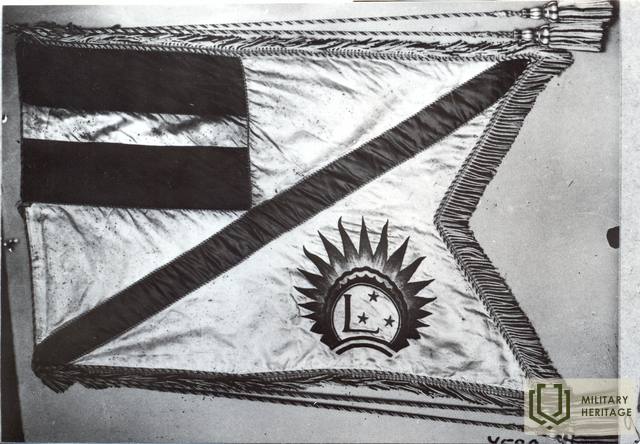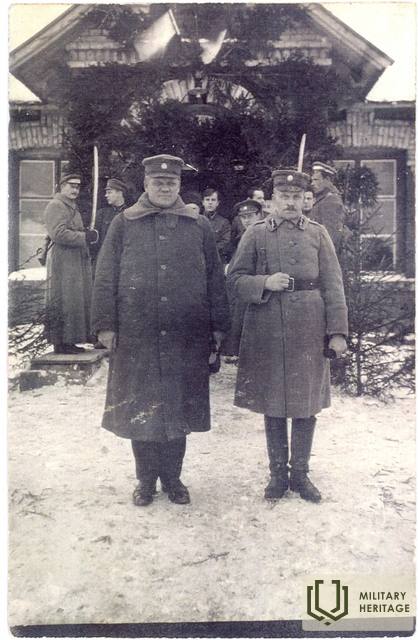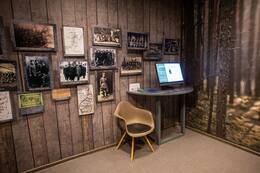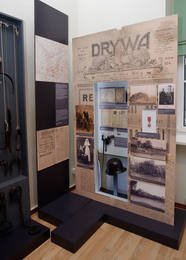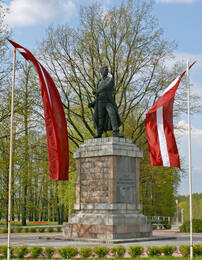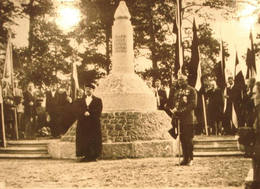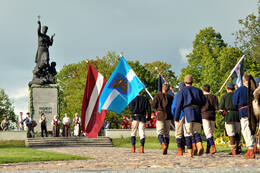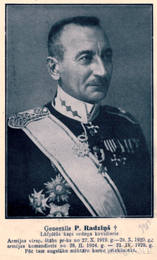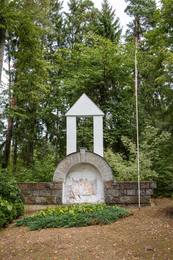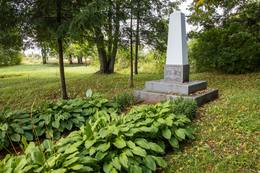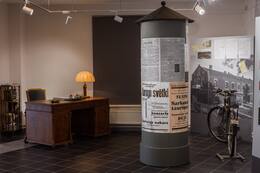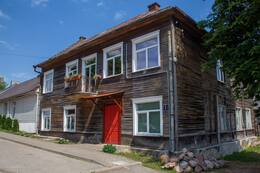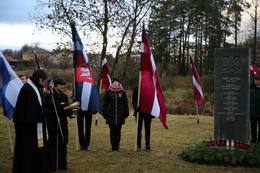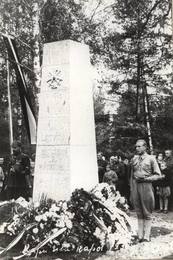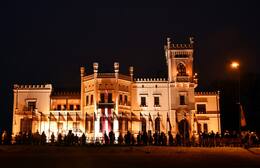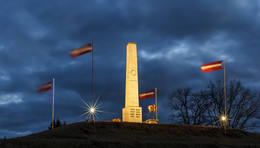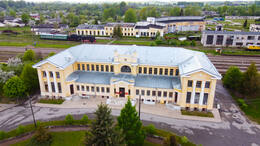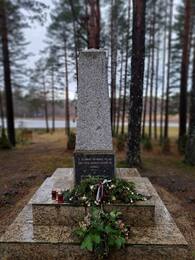Latgales atbrīvošana no lieliniekiem
I Neatkarības kari
Pēc uzvaras pār Pāvela Bermonta spēkiem Latvijas valdība pieņēma lēmumu par Latgales atbrīvošanas operāciju, kam bija nepieciešams kaimiņvalstu atbalsts. Pēc neveiksmīgām sarunām ar Lietuvu decembra beigās virspavēlniecība vienojās par sadarbību ar Polijas armiju. 1920. gada 3. janvārī Polijas un Latvijas spēki pārgāja uzbrukumā Dienvidlatgalē, poļiem atbrīvojot Daugavpili, bet 9.janvārī Latvijas armija – Ziemeļlatgalē, līdz februāra sākumam atbrīvojot visu Latgali.
Latgales atbrīvošanas laikā Latvijas armijas virspavēlnieks bija ģenerālis Jānis Balodis, bet Virspavēlnieka štāba priekšnieks pulkvedis Pēteris Radziņš. Daugavpils ieņemšanas operāciju vadīja Polijas ģenerālis Edvards Ridzs-Smiglijs. Rēzeknes un Latgales centrālās daļas atbrīvošanu vadīja Kurzemes divīzijas komandieris pulkvežleitnants Jānis Puriņš. Ziemeļlatgales atbrīvošanas operāciju vadīja Latgales divīzijas štābs Vecgulbenē ar pulkvedi Krišjāni Berķi priekšgalā.
Vienlaikus 1920. gada janvāra sākumā uz Maskavu devās Latvijas Sarkanā Krusta delegācija, kuras uzdevums bija noslēgt pamieru, kas tika parakstīts 30.janvārī (stājās spēkā 1.februārī). Miera sarunas bija uzsāktas Maskavā 16.aprīlī, bet vasarā turpinājās Rīgā, tās bija atkarīgas arī no notikumiem Padomju Krievijas un Polijas frontē. Miera līgums tika parakstīts Rīgā 1920.gada 11.augustā.
1920. gada aprīlī un maijā karaspēka daļām Latgales frontē pievienojās jaunizveidotā Zemgales divīzija, vienlaikus aprīļa vidū Latviju atstāja Polijas karaspēks, pagaidām paliekot tikai Daugavpilī. Tas pilsētu bija spiests atstāt jūlija sākumā Sarkanās armijas ofensīvas rezultātā. Tad Latvijas spēki pārņēma tagadējās pilsētas Grīvas daļu (tolaik – atsevišķa pilsēta Daugavas kreisajā krastā) un sešus Ilūkstes apriņķa pagastus, kas bija pasludināti par piederīgiem Polijai. Jau pēc miera noslēgšanas 1920. gada septembra sākumā 12. Bauskas kājnieku pulks un citas vienības atspieda Lietuvas armijas vienības Subates rajonā, bet oktobrī Latvijas armija ieņēma pēdējos Ilūkstes apriņķa pagastus, kurus atstāja Lietuvas armija.
Papildus izziņas avoti
Ēriks Jēkabsons. Latvijas Neatkarības karš. Latvijas Pagaidu valdības un tās bruņoto spēku cīņa par Latvijas neatkarības nodrošināšanu 18.11.1918.-11.08.1920.gadā. – Nacionālā enciklopēdija: https://enciklopedija.lv/skirklis/22216-Latvijas-Neatkar%C4%ABbas-kar%C5%A1
Juris Ciganovs. Latgales atbrīvošana 1920. gadā iezīmēja Latvijas Neatkarības kara noslēgumu. SARGS.LV, 03.01.2020. https://www.sargs.lv/lv/latvijas-neatkaribas-kars/2020-01-03/latgales-atbrivosana-1920-gada-iezimeja-latvijas-neatkaribas
Latgales atbrīvošana. Vikipēdija. https://lv.wikipedia.org/wiki/Latgales_atbr%C4%ABvo%C5%A1ana
Ziemeļlatgales atbrīvošanas operācija. Vikipēdija. https://lv.wikipedia.org/wiki/Zieme%C4%BClatgales_atbr%C4%ABvo%C5%A1anas_oper%C4%81cija
Saistītās laikalīnijas
Saistītie objekti
Ekspozīcija “Ziemeļlatgale brīvības cīņās” Balvu Novada muzejā
Muzejs atrodas Balvu muižas apbūves kompleksa teritorijā, bijušajā muižas klēts ēkā. Ekspozīcija ļauj ielūkoties Latvijas Neatkarības kara vēsturē no Ziemeļlatgales skatu punkta, izsekojot Latgales partizā nu pulka izveidošanās un darbības vēsturei. Apskatāmi ie priekš citur neredzēti foto materiāli un dokumentu kopijas, tostarp, 1919. gada 5. jūlija pavēle par pulka izveidošanu. Unikālas ir pulka darbības iekšējās pavēles, kuras laikā no 1919. gada jūlija līdz oktobrim rakstītas krievu valodā. Tas atspoguļo pulka kā vietējās vienības veidošanās īpatnī bas un sastāvu, kur kopā cīnījās, latvieši, latgalieši, krievi un ebreji. Uz latviešu valodu iekšējās pavēlēs pulks pārgā ja tikai pēc pilnīgas iekļaušanās Latvijas armijas sistēmā, kad to papildināja mobilizētie karavīri no citiem Latvijas novadiem. Ekspozīcijā atspoguļota arī Ziemeļlatgales atbrīvošanas operācija, kuras laikā no 1920. gada 9. līdz 15. janvārim Latvijas armijas Latgales divīzija ar kaujām atbrīvoja Viļa kas, Jaunlatgales un Kārsavas apkārtni. Tajā apskatāmas liecības gan par operāciju kopumā, gan Latgales parti zānu pulka kaujas darbību Kārsavas atbrīvošanas laikā.
Preiļu Vēstures un lietišķās mākslas muzeja ekspozīcija "Muzeja stāsti Latvijai"
Atrodas Preiļu kultūras centra telpās.
Apskatāma Preiļu Vēstures un lietišķās mākslas muzeja (PVLMM) ekspozīcija "Muzeja stāsti Latvijai" par Pirmo pasaules, Neatkarības karu un Otro pasaules karu.
Preiļu vēstures un lietišķās mākslas muzeja ekspozīcijas "Muzeja stāsti Latvijai" (atklāta 2018. gadā) sadaļa ""Drywys" stāsts" veltīta Pirmajam pasaules karam, Neatkarības karam un Latgales atbrīvošanai, kā arī Lāčplēšana kara ordeņa kavalieriem. Ekspozīcijas sadaļa "Karoga stāsts" vēsta par Otrajam pasaules kara perioda sarežģītajiem notikumiem, kura laikā preiliešus skāra deportācijas, holokausts, iesaiste karojošo pušu militārajās vienībās, pēc kara - nacionālo partizānu rindās. Apskatāma arī preilietim, ebreju glābējam Vladislavam Vuškānam piešķirtā medaļa “Taisnīgais starp tautām”.
Iepriekš piesakoties, pieejama ekskursija krievu un angļu valodā.
Piemineklis Latgales partizānu pulka kritušajiem karavīriem 1919. - 1920.gads
Latvijas Neatkarības kara (1918.-1920.g.) laikā Balvu novada teritorijā pēc vietējo iedzīvotāju iniciatīvas izveidojās Balvu partizānu nodaļa, kura drīz tika pārveidota par Latgales partizānu pulku.
Doma par pulka pieminekli radās jau 1927. gadā. 1933. gadā bijušais Latgales partizānu pulka karavīrs, akmeņkalis Jānis Pilmanis par saviem līdzekļiem uzcēla 5 metrus augsto akmens postamentu piemineklim. Savukārt pašu bronzas pieminekli veidoja mākslinieks Kārlis Jansons.
Pulka kritušo karavīru piemiņai veltīto pieminekli, piedaloties ģenerālim Jānim Balodim atklāja 1938. gada 14. augustā. Lai arī oficiālais pieminekļa nosaukums bija “Sargājošais partizāns”, tautā piemineklis drīz vien tikai iesaukts par “Balvu Staņislavu”.
Pēc tam, kad Latviju okupēja PSRS, 1941. gada pavasarī ar Abrenes apriņķa izpildkomitejas lēmumu piemineklis tika nojaukts. Augstais postaments tika nojaukts, bet pats bronzas piemineklis palika Balvu milicijas pagalmā.
Vācu okupācijas laikā pieminekļa postaments netika atjaunots, bet pašu bronzas pieminekli novietoja iepriekšējā vietā. Pēc padomju okupantu otrreizējās atgriešanās 1944. gadā piemineklis tika iznīcināts pilnībā.
Latvijai atgūstot valstisko neatkarību, balvenieši vāca ziedojumus Latgales partizānu pieminekļa atjaunošanai. 1993. gada 11. novembrī Balvos atklāja mākslinieka Kārļa Jansona dēla Andreja Jansona atjaunoto pieminekli.
Pieminekļa postamenta aizmugurē tika pievienota papildus piemiņas plāksne ar tekstu “Atjaunots godinot arī 1940. – 1954. gada Latgales nacionālās brīvības cīnītājus”.
Piemineklis Latvijas atbrīvošanas cīņās kritušo karavīru piemiņai Jaškovā
Atrodas ceļa posma Viļaka – Vientuļi (P35) kreisajā ceļa pusē, pie Jaškovas kapu kapličas.
Piemineklis Neatkarības karā kritušajiem latviešu un igauņu karavīriem.
Tēlnieka Kārļa Zemdegas veidotais piemineklis 1920.gadā Brīvības cīņās kritušo karavīru piemiņai Jaškovā pirmo reizi tika atklāts 1935.gada 22.septembrī pie 1929.gadā ierīkotajiem Viļakas brāļu kapiem.
Brīvības cīņās pret sarkano armiju Viļakas novadā sākās ar Latvijas armijas un Latgales partizānu pulka uzbrukumu 1920.gada 9.janvārī. Tajā piedalījās arī igauņu karavīri. Viļaku atbrīvoja jau 9.janvārī, bet cīņas uz austrumiem no tās turpinājās vēl vairākas dienas. Gan pirms, gan pēc Viļakas atbrīvošanas kritušie karavīri tika apbedīti dažādās vietās, ko zināja vietējie iedzīvotāji. Nostabilizējoties Latvijas valstij, Viļakā sāka domāt par kopēju brāļu kapu iekārtošanu. Jau no 1923.gada 18.novembra pēc svinīga dievkalpojuma katoļu baznīcā, kuru noturēja dekāns P.Apšinīks, liels gājiens devās uz jaunveidojamo brāļu kapu vietu uzkalniņā, tā sauktajā Jaškovā - tiešā Viļakas tuvumā. Drīz uzbūvēja pieminekļa pamatus, sākās ziedojumu vākšana piemineklim. Kritušo karavīru kapavietu apzināšana prasīja laiku, tikai 1929.gada 3.novembrī notika pārapbedīšana topošajos brāļu kapos. Tajos apbedīti Viļakas apkārtnē kritušie 31 latviešu un 14 igauņu karavīri.1935.gadā piemineklis bija gatavs un 22.septembrī to svinīgi iesvētīja.
Pirmskara Latvijas valsts neatkarības gados ar brāļu kapiem un šo pieminekli bija saistīti visi valstiski svarīgākie pasākumi Viļakas pagastā.
Piemineklis tika sagrauts pēckara padomju varas gados, bet tā granīta daļas, lai gan bojātas, bija saglabājušās. Pieminekli atjaunoja un 1990.gada 11.novembrī - Lāčplēša dienā.
Piemineklis “Vienoti Latvijai” jeb Latgales Māra
Piemineklis “Vienoti Latvijai”, tautā saukts “Latgales Māra”, atrodas Rēzeknē. Tā centrālais sievietes tēls ar krustu rokā simbolizē 1920. gadā no lielinieku varas atbrīvoto Latgali un tās kristīgās civilizācijas garu. Pieminekļa celšanu iniciēja Latgales sabiedriskie darbinieki 20 gs. 20-tajos gados. Pamatakmens tika ielikts un iesvētīts 1930. gada 8. jūnijā. 1934. gada jūnijā tika izsludināts pie minekļa konkurss, kurā uzvarēja Kārļa Jansona projekts. Pieminekli atklāja 1939. gada 8. septembrī, un iesvētīšanas dievkalpojumu vadīja bīskaps Jāzeps Rancāns. Pēc padomju okupācijas 1940. gada novembrī piemineklis tika nogāzts. Bronzas skulptūras nepaspēja iznīcināt un vācu okupācijas laikā 1943. gada 22. augustā pieminekli atjau noja. Atgriežoties padomju okupācijai, piemineklim sākot nēji tika nozāģēts krusts, bet 1950. gadā to pilnībā iznīcināja.
Padomju okupācijas laikā tā vietā tika uzcelts Ļeņina piemi neklis, kuru novāca tūlīt pēc Latvijas neatkarības atjaunoša nas 1991. gadā. Atmodas laikā 1989. gadā radās ideja par vēsturiskā pie minekļa “Vienoti Latvijai” atjaunošanu. Pieminekli pēc tēva materiāliem un fotogrāfijām no jauna darināja Kārļa Jan sona dēls, tēlnieks Andrejs Jansons, sadarbībā ar Intu Folk mani. Atjaunoto pieminekli atklāja 1992. gada 13. augustā, Pirmā pasaules latgaliešu saieta laikā.
Ģenerāļa Pētera Radziņa piemiņas vieta
Atrodas Valkas pagastā, braucot pa autoceļu Valka – Rūjiena (P22) 4 kilometrā, pa labi, sekojot norādes zīmēm.
Pēteris Radziņš dzimis 1880.gada 2.maijā Lugažu pagasta “Jaunvīndedzēs”. Mācījies Lugažu draudzes skolā, Valkas pilsētas skolā un Valkas Nelsona reālskolā. Iestājies kā brīvprātīgais krievu armijā. 1919.gada rudenī atgriezās Latvijā un 27.oktobrī iecelts par Armijas virspavēlnieka štāba priekšnieku, uzņemoties šo amatu brīdī, kad bermontieši apdraudēja Rīgu. Kā štāba priekšnieks vadījis visas Rīgas, Zemgales un Latgales kaujas. 1920.gada 5.februārī paaugstināts par ģenerāli.
Mūsdienās netālu no dzimtas mājas aplūkojams piemiņas akmens, kas veltīts ģenerālim Pēterim Radziņam (1880 - 1930).
2017.gada 11.novembrī Rīgā, Daugavas gates stūrī, tika atklāta piemiņas plāksne Pēterim Radziņam.
Video: Ģenerāļa P. Radziņa piemiņas pasākums Rīgas Brāļu kapos 2019.gadā
Video: 2019.gada 2. maijā, ģenerāļa Pētera Radziņa 139. dzimšanas dienā, 11.novembra krastmalā, pie Prezidenta pils, goda sardzei un interesentiem piemiņas plāksni aptverot, notika atceres pasākums.
Valkas novadpētniecības muzeja ekspozīcijā “Valka - Latvijas neatkarības šūpulis” atspoguļota arī ģenerāļa Pētera Radziņa dzīve un darbība.
Blakus tradicionālajiem krājuma eksponēšanas veidiem ekspozīcijā izmantoti interaktīvi multimediju risinājumi. Informācija un anotācijas tulkotas igauņu un angļu valodā.
Piemineklis 1. Liepājas kājnieku pulka karavīriem 1919. gada cīņu vietā
Atrodas Madonas novada, Murmastienes pagastā, Meža Strodu ciemā, 6km no Varakļāniem.
Apskatāms Brīvības cīņu piemineklis 1. Liepājas kājnieku pulka kaujas vietā, kur viņi 1919. gadā cīnījās pret ” sarkano” karapulku. Netālu no šīs vietas kaujā smagi tika ievainots novadnieks Aleksandrs Lakstīgala. Tika atrasts miris pie tuvējām mājām. Tādēļ arī izvēlēta šī pieminekļa atrašanās vieta.
1936. gada 16. augustā Brīvības cīņu atcerei atklāj granīta Uzvaras pieminekli ( tā tika saukts tā laika presē ), kurā iegravēti vārdi: ” 1. Liepājas kājnieku pulka cīņu, upuru un uzvaras vieta Latgalē, 1919. gada 26. augustā ar asinīm mēs pirkām katru savas dzimtās zemes stūrīti-tā tagad mūsu.” To uzstādīja Rēzeknes aizsargu pulka vadība, iesvētīja Rēzeknes aizsargu pulka vecākais mācītājs Vincents Tomašūnas ar vietējo draudzes prāvestu Kalinku. Atklāšanas parādi pieņēma Zemgales divīzijas komandieris, Lāčplēša ordeņa kavalieris Žanis Bahs. 1950. gadā tas tika nogāzts un sapostīts. 1996. gada 16. novembrī svinīgi atklāja atjaunoto pieminekli, arī par godu Latvijas Republikas proklamēšanas 78. gadadienai.
Ekspozīcija „Latvijas armija Pļaviņās 20. gs.”
Atrodas Odzienas ielā 2, Pļaviņās.
Apskatāma pastāvīgā ekspozīcija „Latvijas armija Pļaviņās 20. gs.”.
Ēkai Pļaviņās, Odzienas ielā 2, ir sena vēsture – no laika, kad Stukmaņu lieltirgotājs Hugo Apeltofts tajā uzsāka aktīvu saimniecisko darbību, tādējādi veicinādams Pļaviņu pilsētas attīstību, līdz brīdim, kad Brīvības cīņu jeb Neatkarības kara laikā šeit tika izveidots Latvijas Austrumu frontes štābs. 1919. gadā tieši no Pļaviņām tika vadīta Latvijas armijas vienību darbība pret Sarkano armiju Latgalē.
1934. gadā pie šī nama tika atklāta piemiņas plāksne ar uzrakstu: “Šai namā 1919. gadā atradās Austrumu frontes štābs, un šeit ģenerālis Jānis Balodis uzņēmās Latvijas Nacionālās armijas virspavēlniecību.” Padomju vara 1940. gadā to noņēma un iznīcināja, bet 1990. gada 16. jūnijā ar LNNK Pļaviņu nodaļas atbalstu tā tika atjaunota.
Tagad pie kādreizējā štāba ēkas atrodas piemiņas stēla, kas veltīta 15 Pļaviņu novadā dzimušajiem Lāčplēša Kara ordeņa kavalieriem, bet telpās izveidota ekspozīcija „Latvijas armija Pļaviņās 20. gs.”, kura stāsta par notikumiem Brīvības cīņu laikā, Latvijas armijas 3. Latgales divīzijas štāba darbību Pļaviņās, kā arī sniedz ieskatu Lāčplēša Kara ordeņa kavalieru dzīves stāstos.
Netālu no ekspozīcijas ēkas atrodas Latgales divīzijas štāba ēka, kuru 1913. gadā, kā Stukmaņu liķiera fabiku būvēja grāfs Teodors Medems. 1919.gadā to pārņēma P. Stučkas režīms, kur tas bija izveidojis arī cietumu. Pēc boļševiku padzīšanas, 1925.gadā ēku pārņēma Latvijas armija, kura tajā izvietoja Latgales divīzijas štābu. Šajā ēkā savu militāro karjeru izgāja 10 Latvijas armijas ģenerāļi un citi virsnieki. 1940.gadā ēku pārņēma Sarkanā armija. Pēckara gados tajā izvietojās skola, kā arī pašvaldība. Ap 1970.gadu ēku sāka izmantot ražošanas apvienība “Rīgas Apģērbs”.
Ekspozīcijas apmeklējumu iepriekš jāpiesaka zvanot T. 28442692.
Privātekspozīcija “Abrenes istabas”
Ekspozīcija “Abrenes istabas” atrodas Viļakas pilsētā, ēkā ar daudzveidīgu vēsturi. Pirmsākumos ēka atradās uz senā Marienhauzenas tirgus laukuma, vēlāk tajā atradās dzīvokļi, biroji, dažādi veikali, bet Otrā pasaules kara laikā tur darbojās latviešu pašaizsardzības štābs, gestapo un arī čeka. Vairākas ekspozīcijas atklāj dažādus notikumus un vēstures posmus Viļakas pilsētā un tās tuvākajā ap kārtnē laikā no 1920. līdz 1960. gadam, kad Viļaka ietilpa Jaunlatgales Abrenes apriņķī. Tajās redzami priekšmeti no Stompaku purva partizānu mītnes, kas saistīti ar nacio nālo partizānu kustību Latgalē. Apskatāmi arī dokumenti un fotogrāfijas, kas saistīti ar Neatkarības karu. Jaunākā ekspozīcija ir veltīta kādreiz slavenajai motokrosa trasei “Baltais briedis”.
Piemiņas stēla Lāčplēša kara ordeņa kavalieriem
Atrodas līdzās Viļakas Jēzus Sirds Romas Katoļu baznīcai.
Piemiņas stēla Lāčplēša kara ordeņa kavalieriem Viļakas novadā atklāta 2017.gada 11.novembrī. 28 Lāčplēša Kara ordeņa kavalieru likteņi ir saistīti ar Viļakas novada vārdu.
Granīta stēla tapusi Latvijas valsts simtgadei veltītā projekta “Atceries Lāčplēšus” ietvaros. Godinot Latvijas Brīvības cīņās kritušos karavīrus, visā Latvijā tiks uzstādītas vienota parauga piemiņas stēlas. Projekta iniciators ir Jaunsardzes un informācijas centrs.
Pieci Lāčplēša kara ordeņa kavalieri, kuru vārdi iegravēti piemiņas stēlā, pēc Brīvības cīņu noslēguma dzīvoja tagadējā Viļakas novada teritorijā:
– Jānis Kuļšs bija jaunsaimnieks Šķilbēnu pagasta Apsīšos,
– Aleksejs Ļubimovs (Lavrentjevs) dzīvoja Šķilbēnu pagasta Fortepjanovas fermā, vēlāk Viļakā,
– Teodors Mende saimniekoja viņam piešķirtajā saimniecībā un bija mežsargs Žīguru pagasta Katlešu ciemā,
– Eduards Tenisons dzīvoja Vecumu stacijā, vēlāk dzīvoja Čabatrovas ciemā un strādāja p/s “Viļaka”,
– Jānis Burmeistars pēc 1928. g. kādu laiku dzīvojis Šķilbēnu pagastā.
Brāļu kapi Viļakas novadā ir atdusas vieta 45 karavīriem, kuri 1920. gadā atdeva savas dzīvības, aizstāvot Latviju no lieliniekiem. 9. janvāris bija diena, kad uzbrukumi sākās Ziemeļlatgalē, un, neskatoties uz toreiz esošajiem sarežģītajiem laikapstākļiem, tajā pašā dienā arī tika atbrīvota Viļaka.
Latgales atbrīvošanas kaujās Viļakas novadā plecu pie pleca kopā ar Latvijas armijas karavīriem un partizāniem pret Sarkano armiju cīnījās arī Igaunijas karavīri. Daudzi no viņiem atdeva savu dzīvību par brīvu Latviju.
Alūksnes muzejs
Atrodas Alūksnes Jaunās pils telpās.
Alūksnes muzeja piedāvājumā militārais mantojums atspoguļojas pamatekspozīcijās: "Totalitārajā režīmā cietušo piemiņas istaba", kas veidota represiju atcerei un atklāj Alūksnes novada iedzīvotāju likteņgaitas Sibīrijā un Tālajos Austrumos, un Alūksnes vēstures ekspozīcijā "Laikmetu mielasts", kur satiekas laika periodi no aizvēstures līdz mūsdienām. Atsevišķa nodaļa ekspozīcijā veltīta 7. Siguldas kājnieku pulka ieguldījumam militārajā jomā, kultūras un sabiedriskajā dzīvē.
7. Siguldas kājnieku pulks no 1919. gada 20. aprīļa sācis formēties kā 3. Jelgavas kājnieku pulks, no 25. augusta nosaukums – 7. Siguldas kājnieku pulks. Siguldas kājnieku pulks piedalījās kaujās pret Bermontu, tad 1920. gada 5. janvārī ieradās Latgales frontē, kur piedalījās daudzās kaujās, tajā skaitā pie Katlešiem, Vecumu un Purvmalas stacijām, kā arī Jaunlatgales un Augšpils atbrīvošanā. Pēc miera līguma noslēgšanas pulks apsargāja robežu no Rītupes stacijas līdz Igaunijas robežai. Brīvības cīņās krituši 68 karavīri, ar Lāčplēša Kara ordeni apbalvoti 85 karavīri.
Alūksnes muzejs atrodas Valsts nozīmes arhitektūras piemineklī - Alūksnes Jaunajā pilī, kas celta neogotikas stilā 19.gs. beigās. Latvijas pirmās brīvvalsts laikā Alūksnes Jaunajā pilī bija izvietots 7.Siguldas kājnieku pulks.
Pēc Otrā pasaules kara pili pārņēma padomju drošības iestādes, bet no 1950-to gadu beigām pilī darbojušās dažādas kultūras iestādes – izpildkomitejas Kultūras un Kinofikācijas nodaļa, pionieru nams, bibliotēka, bērnu bibliotēka, kinoteātris un muzejs.
Piemineklis Latvijas Neatkarības karā kritušajiem 7. Siguldas kājnieku pulka karavīriem
Atrodas Alūksnes ezera krastā, Pleskavas ielas (Kolberģa ceļa) malā.
1923. gada 22. jūnijā Latvijas Valsts prezidents Jānis Čakste atklāja pieminekli kritušajiem 7. Siguldas kājnieku pulka karavīriem. Piemineklis veidots pēc mākslinieka Jūlija Miesnieka meta.
Pulka karavīri labiekārtoja un uzturēja arī pieminekļa apkārtni. Pie pieminekļa karavīri pulcējās pulka gada svētku priekšvakarā, kad iededzināja svēto uguni, kā arī pulka gada dienā pēc parādes un aizlūguma Garnizona kapos.
1940./1941. gadā boļševiki plāksni noņēma un iznīcināja, bet pašu pieminekli nojauca 1953. gadā un tā akmeņus iemūrēja kazarmu mājas stūra pamatos.
Sākoties Atmodai, 1989. gada rudenī tika sakopta nopostītā pieminekļa apkārtne, kas tolaik vēl atradās PSRS okupācijas karaspēka daļas teritorijā. Pieminekļa kādreizējā atrašanās vietā 11. novembrī tika atklāta pagaidu granīta piemiņas zīme, kurā iekalts teksts: "Šajā vietā tiks atjaunots 7.Siguldas kājinieku pulka piemineklis 11.XI 1989."
Pateicoties Alūksnes Brāļu kapu komitejas nodaļas vadītāja U. Veldres iniciatīvai, tika uzsāki pieminekļa atjaunošanas darbi un 2009. gada 16. oktobrī atklāja atjaunoto pieminekli.
Atšķirībā no pieminekļa oriģināla, uz obeliska pulka krūšu nozīmes vietā tika izveidots krusts. Abus pieminekļa ciļņus kalis tēlnieks Ainārs Zelčs. Atjaunotajam piemineklim tika izmantoti gan daļa no 22 oriģinālā obeliska blokiem, kas tika atrasti Nacionālo bruņoto spēku Kājnieku skolas teritorijā, gan jaunizgatavotie bloki.
2019. gada 20. jūnijā 7. Siguldas kājnieku pulka simtgades pasākumu ietvaros pieminekļa kalna pakājē tika atklāta pulka pieminekļa piemiņas vieta un granīta piemiņas plāksne vienības kritušajiem karavīriem, kurā iekalts teksts: “Jūsu stiprais gars vienmēr ierindā ar mums…”. Piemiņas vieta iekārtota par nacionālo bruņoto spēku Kājnieku skolas personāla saziedotajiem līdzekļiem.
Gulbenes dzelzceļa stacija
Atrodas Gulbenē, Dzelzceļa iela 8
Apskatāma pati stacijas ēka un perons, izveidotā piemiņas plāksne un piemineklis represētajiem (tēln. I.Ranka).
Pirmā pasaules kara laikā (1916.—1917. gadā) šaursliežu līnija uz Pļaviņām pārbūvēta 1524 mm platumā, lai kalpotu kā savienotāja līnija ar Rīgas—Daugavpils līniju. Uzbūvēta arī līnija uz Ieriķiem, kā arī līdz Sitai, izveidojot savienojumu ar Pitalovu. Tādējādi Gulbene kļuva par dzelzceļa mezglu.
Brīvības cīņu laikā, 1919.gada 31.maijā atbrīvojot Gulbeni no lieliniekiem, 1.(4.) Valmieras kājnieku pulks šeit ieguva ievērojamu daudzumu kara trofeju.
Tagadējā stacijas ēka (arh. P.Feders) celta 1926. gadā. No Gulbenes dzelzceļa stacijas 1941. gada 14. jūnijā tika deportēti gan civiliedzīvotāji, gan Litenes vasaras nometnē arestētie virsnieki.
Kā nozīmīga mezgla stacija tika bombardēta 1944.gada pavasarī, pēc kara atjaunota sākotnējā izskatā, 2018.gadā atklāts izglītojošs un interaktīvs centrs „Dzelzceļš un Tvaiks”. Blakus atrodas SIA „Gulbenes –Alūksnes bānītis” ar interaktīvām nodarbībām un ekskursijām.
Arendoles muiža
Arendoles muiža pirmo reizi vēstures avotos minēta 16. gad simtā. Tās īpašnieki laika gaitā vairākkārt mainījušies, muiža piederējusi Grappenbruku, Līdinghauzenu-Vulfu un Plāteru Zībergu dzimtām. Pašreizējo izskatu muiža ieguva pārbūves laikā no 1895. līdz 1901. gadam. Pamatojoties uz agrārās reformas likumu, muižu 1921. gada 14. janvārī atsavināja un nodeva Kalupes pagasta valdes rīcībā.
Muižas kungu māju izremontēja, un 1925. gadā tajā tika ierīkota pamat skola un bāreņu patversme, bet kalpu mājā izveidoja kara invalīdu pansionātu. Skola un invalīdu nams darbojās līdz 1975. gadam. 1995. gadā Arendoles muižas kungu māju iegādājās privāt īpašnieki, un sāka tās atjaunošanu. Kopš 2002. gada muižā darbojas biedrība “Es Latgalei”, kas rūpējas par tās sagla bāšanu un attīstīšanu.
Muižas apmeklētājiem ir iespēja apskatīt atjaunotās telpas un iepazīties ar Latgalē lielāko seno priekšmetu kolekciju, kā arī iegūt informāciju par 20. gadsimta vēstures notiku miem Latgalē. Īpaša ekspozīcija ir veltīta bijušajam Kalupes pagasta policistam Jānim Babrim (1904-1982), kurš 1941. gada 14. jūnijā pretojās deportāciju operatīvajai grupai, nošaujot milici Slicu un ievainojot komunistiskās partijas piln varoto Jozānu. Arendoles muiža piedāvā iespēju pārnakšņot un nomāt telpas dažādu pasākumu rīkošanai.
Latvijas brīvības cīņu piemineklis 3. Jelgavas kājnieku pulka cīņu vietā
Piemineklis 3. Jelgavas kājnieku pulka 1920. gada 16. janvāra brīvības cīņām Latgalē. Ar uzrakstu: “3. Jelgavas kājnieku pulka cīņu vieta uzvaras gājiens pa Latgali. 1920.16.I. Mēs nesām sauli, brīvību un patstāvību Latvijai”
Pieminekli atklāja 1936. gada. 16. augustā ģenerālis Žanis Bachs (1885. – 1941.), iesvētīja mācītājs Ādams Vizulis (1891. – 1970). Pieminekļa meta autors Inženieris Zilēvičs
Latvijas Neatkarības kara (1918.–1920.) Latgales atbrīvošanas operācija sākās 1920. gada 3. janvārī. Līdz janvāra vidum Latvijas un Polijas armija no Krievijā varu sagrābušajiem lielinieku spēkiem bija atbrīvojušas Daugavpili un lielāko daļu Latgales dienvidu līdz Dagdas – Indras līnijai. 9. janvārī sākas Latvijas armijas uzbrukums Ziemeļlatgalē, kurš strauji virzījās Kārsavas un Pitalovas staciju virzienā.
Pa vidu starp abiem uzbrukumu virzieniem palika lielinieku kontrolētais rajons Varakļānu, Viļānu un Rēzeknes apkārtnē. 20. janvārī Latvijas armijas vienības sāka Rēzeknes atbrīvošanas operāciju. Jau 21. janvārī tika atbrīvota Rēzekne. Latvijas armija visā Austrumu frontes plašumā sasniedza latviešu apdzīvoto zemju robežu janvāra beigās. Jau 1. februārī Padomju Krievija parakstīja pamiera līgumu ar Latviju.
Ar uzvaru Latgales kaujās tika iegūta Latvijas Austrumu robeža un iespēja Latgali pievienot Latvijai. Latvijas armija 1920. gadā izkaroja galīgo Latvijas apvienošanu un neatkarību.
Piemineklis ar datējumu 1920.16.I. ir veltīts brīdim, kad 3. Jelgavas kājnieku pulks nostājās izejas pozīcijās pirms Rēzeknes atbrīvošanas operācijas.
Saistītie stāsti
Ziemeļlatgales atbrīvošana no lieliniekiem
1918.gada 1.decembrī Sarkanās armijas daļas, kuru pamatā bija Sarkano Strēlnieku vienības, iebruka Latvijas teritorijā. Lai aizsargātu savas mājas, ģimenes, dzimto novadu un paglābtos no terora Balvu apkārtnes vīri ņēma rokās ieročus un gāja mežos, sākās pirmo “zaļo” pulciņu veidošanās. 1919.gada pavasarī, kad izsludināja mobilizāciju, daudziem Balvu apkārtnes vīriem karošana Padomju Latvijas armijā nebija pieņemama un viņi pievienojās “zaļo” pulciņiem. Izveidojās Balvu, Silakroga, Rugāju, Teteru-Dūrupes un Liepnas pulciņi. Balvu apkārtnē “zaļo” pulciņu darbība aktivizējās 1919.gada martā.
Latvijas armijas ģenerāļa, divkārtējā Lāčplēša Kara ordeņa kavaliera Pētera Radziņa piemiņai
Ģenerālis Pēteris Radziņš, dzimis Valkas apriņķa Lugažu pagastā vienkāršā lauksaimnieka ģimenē, kurā iemācījies darīt lauku darbus. Bijis ļoti gudrs jaunietis, pēc skolas beigšanas izlemj par labu kara gaitām un tā sākās viņa armijas gaitas izglābjot Latviju no Bermonta karaspēka. P.Radziņš bija viens no izcilākajaiem Latvijas armijas virsniekiem un apbalvots ar neskaitāmiem Latvijas un ārvalstu ordeņiem un piemiņas zīmēm.




